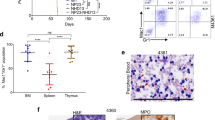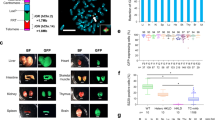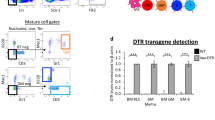Abstract
We have developed a system which can be used to study the mechanisms that may govern the expression of human α-globin genes in human erythroid and non-erythroid haematopoietic cells1,2. Human chromosome 16, which has been shown to bear the human α-globin genes3, is introduced by cell fusion into mouse erythroleukaemia (MEL) cells to generate continuously proliferating cell lines that retain permanently the human α-globin genes. We have shown that hybrid diploid MEL cells with human α-globin genes from erythroid donor cells express these genes fully through globin chain synthesis, while hybrid diploid MEL cells containing human α-globin genes from non-erythroid human haematopoietic donor cells contain very low levels of human α-globin mRNA and no detectable human α-globin chains. The levels of human α-globin mRNA in these hybrid cells were found to depend on factors present in the MEL recipient cell as well as on the differentiated state of the human donor cell, suggesting that this system may be suitable for characterisation of mechanisms governing haematopoietic differentiation in man.
This is a preview of subscription content, access via your institution
Access options
Subscribe to this journal
Receive 51 print issues and online access
$199.00 per year
only $3.90 per issue
Buy this article
- Purchase on Springer Link
- Instant access to full article PDF
Prices may be subject to local taxes which are calculated during checkout
Similar content being viewed by others
References
Deisseroth, A. & Hendrick, D. in Cellular and Molecular Regulation of Hemoglobin Switching (ed. Stammatoyannopoulos, G. & Nienhuis, A.) 761–777 (Grune and Stratton, New York, 1978).
Deisseroth, A. & Hendrick, D. Cell 15, 55–63 (1978).
Deisseroth, A. et al. Cell 12, 202–218 (1977).
Friend, C., Scher, W., Holland, J. & Sato, T. Proc. natn. Acad. Sci. U.S.A. 68, 378–382 (1971).
Gilmour, R. S., Harrison, P. R., Windass, J. D., Affara, N. A. & Paul, J. Cell Diff. 3, 9–22, (1974).
Birnie, G. D., MacPhail, E., Young, B. D., Getz, M. J. & Paul, J. Cell Diff. 3, 221–232 (1974).
Deisseroth, A. & Hendrick, D. Proc. natn. Acad. Sci. U.S.A. 76, 2185–2189 (1979).
Tischfield & Ruddle, F. Proc. natn. Acad. Sci. U.S.A. 76, 45–49 (1974).
Boyum, A. Scand. J. clin. Lab. Invest. 21, Suppl. 97, 97–99 (1968).
Clarke, B. J. & Housman, D. Proc. natn. Acad. Sci. U.S.A. 74, 1105–1109 (1977).
Gianni, A. M. et al. Nature 274, 610–611 (1978).
Miller, D. N., Turner, P., Nienhuis, A., Axelrad, D. C. & Gopalkrishnan, T. V. Cell 15, 511–521 (1978).
Kozak, C., Lawrence, J. & Ruddle, F. Expl Cell. Res. 105, 109–117 (1977).
Yoshida, M. C., Ikeuchi, R. & Sasake, M. Proc. Jap. Acad. 51, 184–187 (1975).
Clegg, J. B., Naughton, M. A. & Weatherall, D. F. J. molec. Biol. 19, 91–108 (1966).
Aviv, H. & Leder, P. Proc. natn Acad. Sci. U.S.A. 69, 1408–1412 (1972).
Forget, B. G., Housman, D., Benz, E. & MaCaffrey, R. P. Proc. natn. Acad. Sci. U.S.A. 72, 984–988 (1975).
Author information
Authors and Affiliations
Rights and permissions
About this article
Cite this article
Deisseroth, A., Bode, U., Fontana, J. et al. Expression of human α-globin genes in hybrid mouse erythroleukaemia cells depends on differentiated state of human donor cell. Nature 285, 36–38 (1980). https://doi.org/10.1038/285036a0
Received:
Accepted:
Issue Date:
DOI: https://doi.org/10.1038/285036a0
This article is cited by
-
Major chromatin changes accompany extinction of ?-fetoprotein gene in hepatoma � fibroblast hybrids
Somatic Cell and Molecular Genetics (1991)
-
Gene modification: Targeting in mammalian cells
Nature (1985)
-
Human globin gene expression in hybrid 2S MEL � human fibroblast cells
Somatic Cell and Molecular Genetics (1984)
-
Regulation of Thy-1 and Pgp-1 glycoproteins in hybrids between T-cell lymphomas and Abelson-leukemia-virus-induced lymphomas
Immunogenetics (1984)
-
Regulation of human globin gene expression in mouse erythroleukemia � human fibroblast hybrid cells
Somatic Cell Genetics (1982)
Comments
By submitting a comment you agree to abide by our Terms and Community Guidelines. If you find something abusive or that does not comply with our terms or guidelines please flag it as inappropriate.



